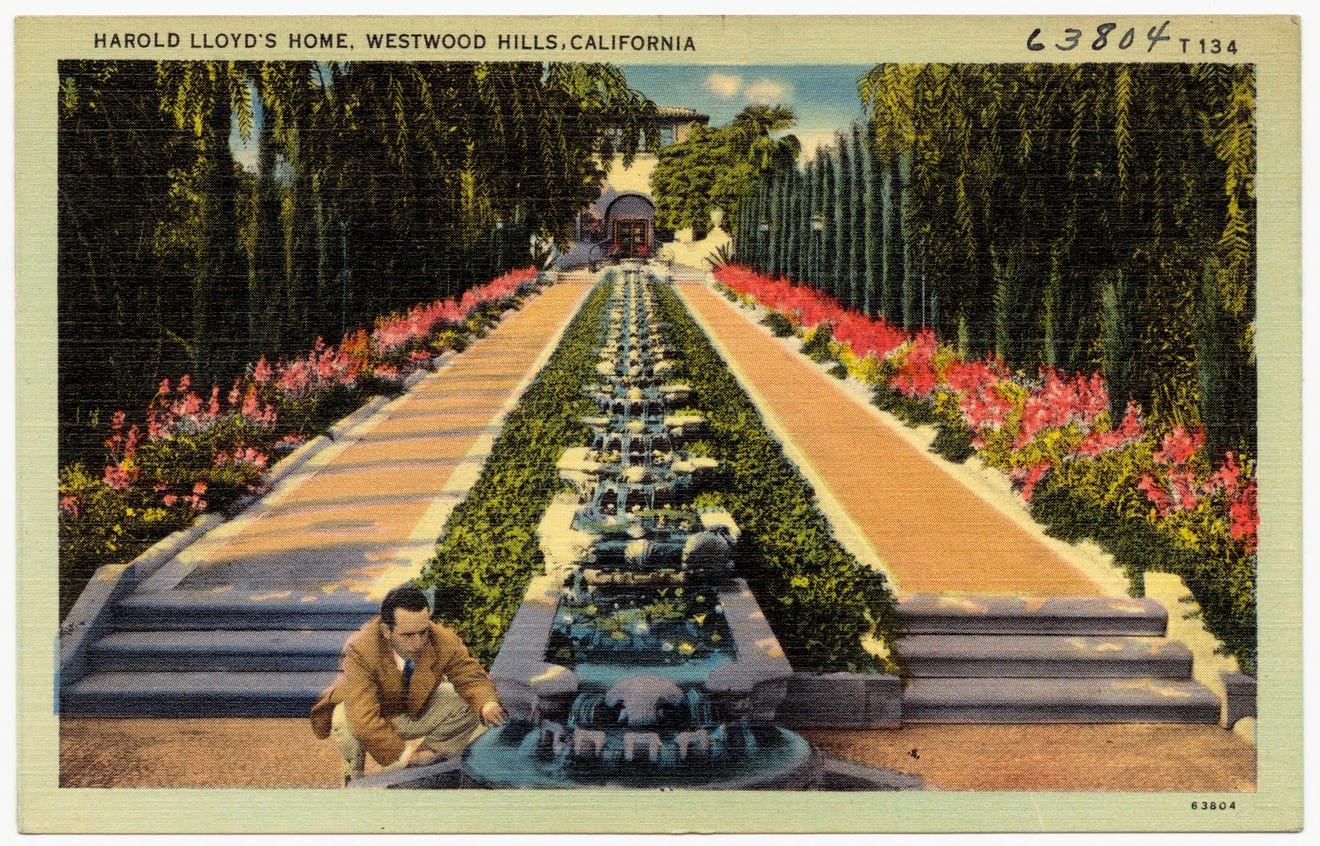
By Tracy Conrad, president of the Palm Springs Historical Society
Harold Lloyd was spectacularly successful by most any measure, but he is not as well-known now as his many accomplishments warrant. Like many important and interesting people of the early 20th century, he came to Palm Springs. Though Lloyd was as famous at the time as his contemporaries Charlie Chaplain and Buster Keaton, the memory of him has faded, undeservedly.
Lloyd came from most humble and tenuous beginnings. His mother cultivated an abiding love of the theater in him. When unable to sustain himself on the stage alone, he broke down and took a job in moving pictures in order to eat. Working regularly, he never looked back. He made some 200 motion pictures between 1914 and 1947, and successfully transitioned from silent to talking pictures. He produced and starred in his own films, exerting unusual control for the time, and in the process made an enormous fortune which he subsequently put to good use.
He unabashedly purchased a series of fine homes in Los Angeles culminating in assembling a gorgeous swath of land in Benedict Canyon on which he constructed, beginning in July 1927 and finishing by year-end in 1928, a grand 44-room mansion called Greenacres. And, as the name suggests, the acreage was even more impressive than the house. Lloyd and landscape engineer A.E. Hanson dreamed up plans for the “largest initial private landscaping project ever attempted” in the Los Angeles area.
There were numerous gardens: tropical, sunken, formal, rose, Italian and terraced. The grounds featured a children’s village with a four-bedroom, thatched-roof house with electricity and running water, a miniature barn described as a “fairyland estate,” a golf course, bridle path, a canoe run, dance pavilion, open-air theater, man-made stream, and the largest swimming pool in California: 50 by 150 feet with the new inventions for filtration and chlorination, and a glass-windowed side for viewing swimmers from the adjacent tunnel.
(The swimming pool was the site of a 1953 film shoot with Marilyn Monroe that was captured behind the scenes in glorious Kodachrome stills by Lloyd himself and was recently the subject of an article by Cari Beauchamp in Atla Journal that’s worth looking up. Marilyn looks picture-perfect in a gorgeous, red bathing suit.)
There were stables for horses, cattle and sheep. A farm and greenhouses for growing vegetables and flowers for the house. Tennis court, handball court and outdoor bowling green. But the waterfall cascade and surrounding gardens, modeled on Villa Gamberaia in Italy, was most impressive of all.
Located in The Movie Colony on North Avenida Palmas, the low-slung, L-shaped house cast a small footprint on its expansive property. “It wasn’t made to be fussy, it was cozy,” recalled Suzanne Lloyd, Harold’s granddaughter, who spent a good deal of her childhood there. She noted for Palm Springs Life Magazine, ‘It was a family house, a place to go and hide out and have fun. He liked having land, he had neighbors he liked. It was a happy place and everyone enjoyed it.'”
Sue Lloyd spent some 20 years coming to the desert with her grandparents and has fond memories of the house and its lush grounds and the many friends in the neighborhood. Across the street was Cary Grant, and kitty-corner was Dinah Shore. Charlie Farrell was across the way. It wasn’t called the Movie Colony for nothing.

The family were close friends with Robert Wagner (who would eventually spend a lot of time in the desert) and Sue tells a story of how they met. Her mother, Gloria, “found RJ at a wedding and brought him home” to Harold, who promptly procured him an agent, and the rest is the stuff of celebrity and movie star magic. They are still close, and Sue still calls him “R baby.”
While Harold Lloyd might not be as recognized as he should be now, the antics he invented and performed for his movies have become iconic, copied innumerable times. He was a highly important star in the nascent movie business and was first among the many notables it produced. After retiring from movies, Lloyd became an expert 3D photographer, traveling the world taking pictures, ultimately amassing a collection of 300,000 stereo slides. He mastered chess, bowling, microscopy and painting. His philanthropy was legendary, and he became a fixture in the business and social communities in the desert.
Greenacres, his magnificent estate, situated on so much extremely valuable land, was subdivided after Lloyd’s death, decimating the gardens and swimming pool. The house was finally saved by Ron Burkle, who also owns Bob Hope’s John Lautner-designed Palm Springs Southridge house. The Lloyd estate in the Movie Colony hasn’t fared as well. It’s been remodeled multiple times, making it almost unrecognizable.
Source: The Desert Sun
